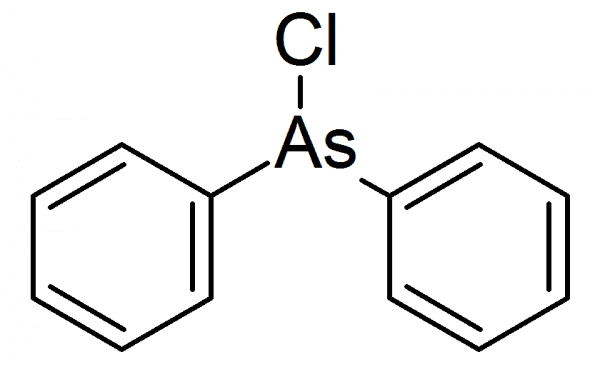Abbreviations Ph2AsCl Molar mass 264.59 g/mol Boiling point 333 °C | Formula C12H10AsCl Density 1.55 g/cm³ | |
 | ||
Appearance colorless crystalline solid | ||
Diphenylchloroarsine (DA) is the organoarsenic compound with the formula (C6H5)2AsCl. It is highly toxic and was once used in chemical warfare. It is also an intermediate in the preparation of other organoarsenic compounds. The molecule consists of a pyramidal As(III) center attached to two phenyl rings and one chloride.
Contents
Preparation and structure
It was first produced in 1878 by Michaelis and La Coste. It is prepared by the reduction of diphenylarsinic acid with sulfur dioxide. An idealized equation is shown:
Ph2AsO2H + SO2 + HCl → Ph2AsCl + H2O + SO3The structure consists of pyramidal As centre. The As-Cl distance is 2.26 A and the Cl-As-C and C-As-C angles are 96 and 105°, respectively.
Uses
It is a useful reagent for the preparation of other diphenylarsenic compounds, e.g. by reactions with Grignard reagents:
RMgBr + (C6H5)2AsCl → (C6H5)2AsR + MgBrCl(R = alkyl, aryl)Chemical warfare
Diphenylchlorarsine was used as a chemical weapon on the Western front during the trench warfare of World War I. It belongs to the class of chemicals classified as vomiting agents. Other such agents are diphenylcyanoarsine (DC) and diphenylaminechlorarsine (DM, adamsite). Diphenylchlorarsine was sometimes believed to penetrate the gas masks of the time and to cause violent sneezing, forcing removal of the protecting device. The Germans called it "Maskenbrecher", "mask breaker", together with other substances with similar effect: Adamsite, diphenylarsincyanide, diphenylaminarsincyanide. Fortunately, this gas did not actually penetrate masks any better than other gases.
Safety
Diphenylchlorarsine is known to cause sneezing, coughing, headache, salivation, and vomiting. China and Japan are negotiating remediation of stocks of a variety of organoarsenic weapons dumped in northeastern China after Japan's numerous invasions of China, including chlorodiphenylarsine.
